Isabella Bradford's Blog, page 26
October 18, 2017
From the Archives: Finding Conjugal Bliss in Dr. Graham's Celestial Bed, 1781
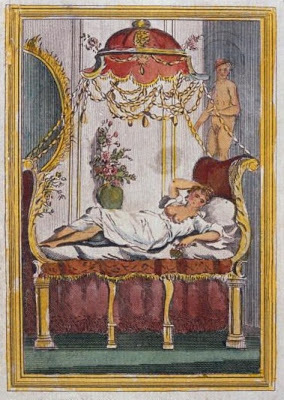 Susan reporting:
Susan reporting:We TNHG are generally very good at remembering things that happened two hundred years ago, but during the last ten - not so much. Sometimes it takes a reader to jog our memories about old posts that are worthy of a return appearance. Many thanks to Alun Withey for reminding me of this post that first appeared back in 2011!
Exploiting the love-lives of the rich and famous is hardly a new pursuit. From ancient times, charlatans have offered exotic, expensive potions to increase flagging libidos and unusual regimes designed to restore the magic to chilly marriages. One of the most infamous of these is Dr. James Graham (1745-1794), a self-proclaimed physician, self-promoter, and inventor (Wikipedia luridly categorizes him as a "sexologist") who captured the imagination of English society in the 1780s – and a good deal of their money besides.
Like all good quacks, Dr. Graham had a splendid gimmick, and his was the Temple of Hymen in Shomberg House in Pall Mall, a kind of overwrought clinic for his unusual treatments. His most profitable speciality was improving conjugal sex and fertility, and he found a clamoring audience among the upper classes whose survival depended on producing healthy heirs. Many of his customers were weakened by venereal disease and general dissipation, but that didn't stop Dr. Graham from making the same outlandish guarantees that often appear today in spam folders. His celebrity clientele included politicians John Wilkes and Charles James Fox, aristocrats such as the Duchess of Devonshire and the Duke of Richmond, and courtesans like Elizabeth Armistead and Mary Robinson.
While his treatments varied from elixirs to mud baths, the centerpiece of the Temple of Hymen was the Celestial Bed. This over-sized bed (it measured nine by twelve feet) could be tilted for an optimum angle, and was supported by glass rods that could permit the bed and its occupants to become so charged with static electricity that it gave off a greenish glow. Decorative automata, a pair of live turtle doves, and lush bouquets of fresh flowers were also features of the bed. Adding to the ambiance was a mattress stuffed with a special mixture of sweet-smelling herbs and hair from the tails of the most rampant English stallions, while a special celestial pipe organ played music calculated to inspire love-making. For the next three years, until Dr. Graham's extravagance landed him in prison for debt and bankruptcy, there were plenty of couples eager for the experience.
The price of a magical night in the Celestial Bed? An astonishingly steep fifty pounds. Did it work? Perhaps – though who wanted to admit that it didn't?
In honor of Valentine's Day, 2011, the Museum of London is recreated Dr. Graham's Celestial Bed as a special adults-only exhibition. For more information about this, as well as more detailed descriptions of Dr. Graham's claims, see here – though be forewarned that this post, like the exhibition, is probably best not read at work.
Above: The Celestial Bed, with the Rosy Goddess of Health reposing thereon, unknown artist, English School, 1782, private collection.
Published on October 18, 2017 21:00
October 16, 2017
London's Kensal Green Cemetery
 Loretta reports:
Loretta reports:I’ve posted before about the garden cemetery movement, and the development of municipal cemeteries in response to overcrowded and squalid burial grounds. Thanks to my husband, I discovered in London The General Cemetery of All Souls, Kensal Green—more generally known as Kensal Green Cemetery. There, in the course of a tour, I discovered the burial places of many persons I’d learned about while researching my books. One of these was the famous Regency-era equestrian Andrew Ducrow, whose tomb I blogged about .
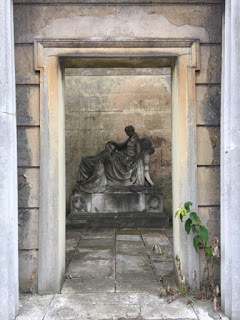 Today we’ll take a look at this beautiful cemetery itself.
Today we’ll take a look at this beautiful cemetery itself. Interestingly, like Worcester’s Rural Cemetery , it got started thanks to a lawyer, George Frederick Carden. Like so many others in the garden cemetery movement, he was inspired by Père Lachaise Cemetery in Paris. Unlike many others, though, Kensal Green, London’s first commercial cemetery, is still run by the original company, the General Cemetery Company, under its original Act of Parliament. In the beginning, however, business looked a little shaky. Though it opened in 1833, it wasn't exactly overwhelmed with customers. Then in 1843 the Prince Augustus Frederick, Duke of Sussex—one of King George III's many sons—decided to be buried there because Windsor’s burial facility apparently gave him the creeps. Thenceforth Kensal Green became THE place to be planted.
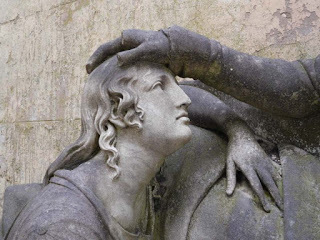 Detail of the second monument
Detail of the second monument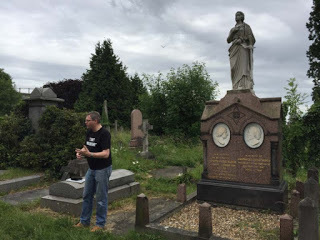 Our fabulous tour guides true. Though not nearly as well-known today as
Highgate Cemetery
, Kensal Green was, until shortly after the turn of the 20th century, the most fashionable cemetery in England. Everybody who was anybody wanted to be buried here.
Our fabulous tour guides true. Though not nearly as well-known today as
Highgate Cemetery
, Kensal Green was, until shortly after the turn of the 20th century, the most fashionable cemetery in England. Everybody who was anybody wanted to be buried here. Like Highgate, sadly, it could use some TLC. Monuments, like Ducrow’s, are crumbling. The Friends of Kensal Green have been working to research and restore the monuments. It was one of these Friends who led our walking tour, and his love of the place was clear. If you are in London, I strongly recommend you take one of their Sunday tours. Along with the amazing variety of monuments, the stories about the famous and less so, there’s abundant nature—the plantings, the birds and other wildlife—to create a very special refuge from the bustle of the metropolis.
For more of the story and the denizens of the place, please visit the Friends of Kensal Green website and the Kensal Green Cemetery website .
All photographs copyright © 2017 Walter M. Henritze III.
Please click on images to enlarge.
Published on October 16, 2017 21:30
October 15, 2017
Visiting the c1765 Schuyler Mansion in Albany, NY
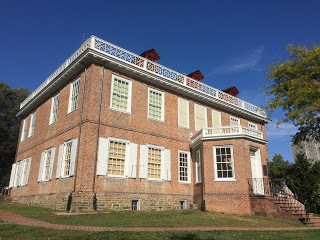 Susan reporting,
Susan reporting,This weekend I visited one of my favorite historic houses, the Schuyler Mansion in Albany, NY. Originally known as The Pastures when it was built in the 1760s, the large brick house was built by Philip Schuyler (1733-1804), who was one of George Washington's original four generals during the American Revolution, a state senator, and a successful business entrepreneur.
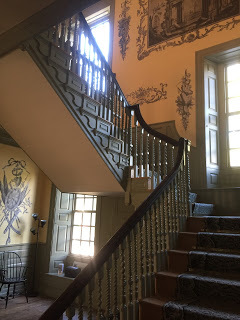
The Pastures was surrounded by nearly a hundred acres of orchards and formal gardens, and filled with costly furnishings imported from London. Guests (who included George and Martha Washington, the Marquis de Lafayette, Benjamin Franklin, and Francois Alexandre, the Duc de La Rouchefoucauld-Liancourt) remarked both upon the house's grandeur and the Schuylers' warm hospitality.

Philip Schuyler's grand house remained in the family for only a single generation, however, and was sold by his children after his death. The house passed through numerous owners, and in the late 19thc it became the home of the St. Vincent's Orphan Asylum Society, serving as a dormitory for orphans. In 1911, the diocese sold the house to the State of New York for $40,000. A Board of Trustees (including three women) oversaw the house's preservation and restoration. Renamed the Schuyler Mansion, the house opened to the public on October 17, 1917, fittingly on the anniversary of the British defeat at the Battle of Saratoga.

Now operated under the auspices of the New York State Office of Parks, Recreation and Historic Preservation (NYS OPRHP), the Schuyler Mansion has celebrated its centennial as a historic site this year in grand style with projects that have included restoring the steps leading to the house's front door; recreating the "Ruins of Rome" scenic wallpaper in the halls (see my earlier blog post here, and another about the elaborate wool flock wallpaper found in several of the rooms); restoring Schuyler family silver and china for display; replacing the roof and repairing exterior woodwork; and restoring and reupholstering an elegant set of 1790s chairs and sofa that had belonged to the family.
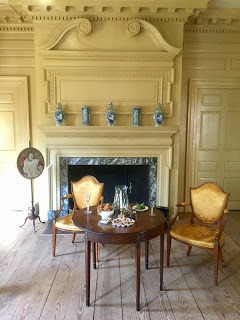
The Schuyler Mansion was also the childhood home of Elizabeth Schuyler Hamilton, the heroine of my new historical novel I, Eliza Hamilton . The house was also the site of Eliza's marriage to Alexander Hamilton and the birth of their first child, and she continued to return to it frequently through her parents' lifetimes.

This weekend the house welcomed Schuyler Family descendants (as well as this non-family-member.) With the shutters opened to the bright autumn sunshine, the rooms and furnishings were beautiful; the 18thc Schuylers would have been proud.
While the Schuyler Mansion's visitor season is winding down, the house is open for various tours and events and by appointment throughout the year. See the house's Facebook page for more information.
Many thanks to Jessie Serfilippi for the private tour, and thanks, too, to the Friends of Schuyler Mansion and the Schuyler Family reunion for welcoming me so warmly to their events this weekend.
All photos ©2017 by Susan Holloway Scott.
Published on October 15, 2017 19:04
Visiting the c1760 Schuyler Mansion in Albany, NY
 Susan reporting,
Susan reporting,This weekend I visited one of my favorite historic houses, the Schuyler Mansion in Albany, NY. Originally known as The Pastures when it was built in the 1760s, the large brick house was built by Philip Schuyler, one of the wealthiest and most prominent men in colonial New York, and also one of George Washington's original four generals during the American Revolution.

The Pastures was surrounded by nearly a hundred acres of orchards and formal gardens, and filled with costly furnishings imported from London. Guests (who included George and Martha Washington, the Marquis de Lafayette, Benjamin Franklin, and Francois Alexandre, the Duc de La Rouchefoucauld-Liancourt) remarked both upon the house's grandeur and the Schuylers' warm hospitality.

Philip Schuyler's grand house remained in the family for only a single generation, however, and was sold by his children after his death. The house passed through numerous owners, and in the late 19thc it became the home of the St. Vincent's Orphan Asylum Society, serving as a dormitory for orphans. In 1911, the diocese sold the house to the State of New York for $40,000. A Board of Trustees (including three women) oversaw the house's preservation and restoration. Renamed the Schuyler Mansion, the house opened to the public on October 17, 1917, fittingly on the anniversary of the British defeat at the Battle of Saratoga.

Now operated under the auspices of the New York State Office of Parks, Recreation and Historic Preservation (NYS OPRHP), the Schuyler Mansion has celebrated its centennial as a historic site this year in grand style with projects that have included restoring the steps leading to the house's front door; recreating the "Ruins of Rome" scenic wallpaper in the halls (see my earlier blog post here ); restoring Schuyler family silver and china for display; replacing the roof and repairing exterior woodwork; and restoring and reupholstering an elegant set of 1790s chairs and sofa that had belonged to the family.

The Schuyler Mansion was also the childhood home of Elizabeth Schuyler Hamilton, the heroine of my new historical novel I, Eliza Hamilton . The house was also the site of Eliza's marriage to Alexander Hamilton and the birth of their first child, and she continued to return to it frequently through her parents' lifetimes.

This weekend the house welcomed Schuyler Family descendants (as well as this non-family-member.) With the shutters opened to the bright autumn sunshine, the rooms and furnishings were beautiful; the 18thc Schuylers would have been proud.
While the Schuyler Mansion's visitor season is winding down, the house is open for various tours and events and by appointment throughout the year. See the house's Facebook page for more information.
Many thanks to Jessie Serfilippi for the private tour.
All photos ©2017 by Susan Holloway Scott.
Published on October 15, 2017 19:04
October 14, 2017
Breakfast Links: Week of October 9, 2017
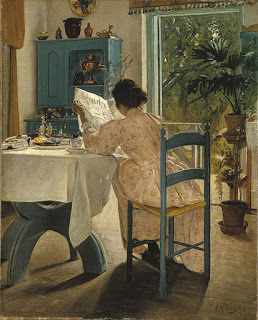 Breakfast Links are served - our weekly round-up of fav links to other web sites, articles, blogs, and images via Twitter.
Breakfast Links are served - our weekly round-up of fav links to other web sites, articles, blogs, and images via Twitter.• Neshobe Island, the Algonquin Round Table summer home in Vermont.
• The Vikings were never a pure-bred "master race," but a blending of people and cultures.
• The United Order of Tents , a secret society of black women founded to help women escape slavery, and still active today.
• Working out the Early Victorian way.
• The chic and imaginative world of shop window displays .
• Catherine Hogarth Dickens , the forgotten wife of Charles Dickens.
• Image: Beautifully beaded 1925 dropped-waist dress by Callot Soeurs .
• Nineteenth-century workers photographed with the tools of their trade.
• Mary Steward's escape from Gloucester's city gaol, 1799.
• Early 20thc postcards from London's Petticoat Lane .
• The monsters of East L.A., and why the folklore and ghost stories we tell matter.
• Cholera and its suggested remedies in the mid-19thc.
• Donuts and apple cider: an autumn marriage made by autos and automation.
• Image: Her poor husband, having to eat vegetables...advertisement, 1934.
• A drop of water that fell into Lake Superior in 1826 is just now leaving the lake.
• The myth of mummy wheat .
• "Lines of women slaving away, hopelessness on every face": Liverpool's Magdalene Laundry at Kelton House.
• Americans in Paris , c1905: The Chinese Umbrella restaurant.
• Victorian bereavement bling .
Hungry for more? Follow us on Twitter @2nerdyhistgirls for fresh updates daily.
Above: At Breakfast by Laurits Andersen Ring. Private collection
Published on October 14, 2017 14:00
October 12, 2017
Friday Video: Dressing an 18thc Lady, Continued: The Busk
Susan reporting,
Last month I shared a video from the Lady Lever Art Gallery and National Museums of Liverpool that demonstrated how an 18thc elite woman was dressed for her day.
Many of you were mystified by one particular wardrobe feature: the busk.
You weren't alone. According to Pauline Loven, the costume historian, costumer, and heritage film producer who created the costumes and contributed the historical background for the first video, the purpose of the busk perplexed many viewers - so much so that this second, shorter video was made to offer further explanation. Both videos were directed by Nick Loven for Crow's Eye Productions.
For examples of several antique busks, see this post from our archives.
If you received this post via email, you may be seeing a black box or empty space where the video should be. Click here to view the video.
Published on October 12, 2017 21:00
October 11, 2017
The Whittall Mills: Survivors of the Industrial Age
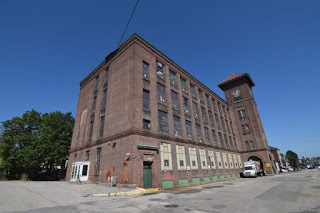 No. 1 Brussels Street
No. 1 Brussels StreetLoretta reports:
Like most cities, my hometown has lost large chunks of its architectural heritage, for a variety of reasons.* Recently, I was surprised and heartened to discover that one large mill complex has managed to survive—not every single building, but most of them—thanks to local business people as well as our dedicated preservationists. Not long ago, under the auspices of Preservation Worcester , Breanna Barney gave a group of nerdy Worcester history people a talk and tour of the Whittall Mills in South Worcester.
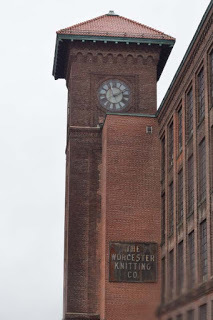 Tower of No. 1 Brussels StreetUntil I attended Ms. Barney’s talk, I didn’t realize that this area was a British enclave. Matthew J. Whittall, ** an Englishman from Kidderminster, had been working in the carpet industry since he was fourteen. At the invitation of George Crompton, who was building a factory to make Brussels carpets, Whittall came to the U.S. in the early 1870s. In 1879, during the global depression, when he found himself unemployed, he decided to go into business for himself. He returned to England, bought eight Crossley carpet looms, and brought them back to Worcester, along with a cousin and a group of Kidderminster carpet weavers.
Tower of No. 1 Brussels StreetUntil I attended Ms. Barney’s talk, I didn’t realize that this area was a British enclave. Matthew J. Whittall, ** an Englishman from Kidderminster, had been working in the carpet industry since he was fourteen. At the invitation of George Crompton, who was building a factory to make Brussels carpets, Whittall came to the U.S. in the early 1870s. In 1879, during the global depression, when he found himself unemployed, he decided to go into business for himself. He returned to England, bought eight Crossley carpet looms, and brought them back to Worcester, along with a cousin and a group of Kidderminster carpet weavers.He was not without strong competition, but by 1901 he’d won, becoming south Worcester’s largest employer. His well-regarded carpets were in Pullman train cars, the Manhattan Opera House, the new Worcester City Hall, and President McKinley’s White house. A sample advertisement is here .
Ms. Barney described him as a paternalistic employer—and this article (which I found after the talk), describing the development of this area, tells a similar story. According to Ms. Barney, in 1910, for instance, business was so good that “Whittall gave weavers an advance in wages.” Furthermore, they would work only 58 hours a week but get paid for 60 hours. This wasn't common behavior among U.S. industrialists, so far as I can ascertain.
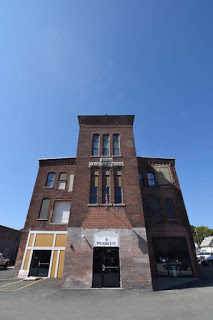 No. 6 Brussels Street (front)
No. 6 Brussels Street (front)
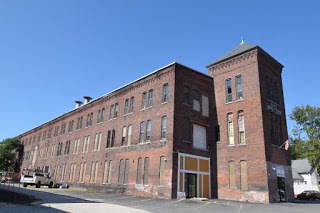 No. 6 Brussels Street (side view)In the course of my own internet search, I learned that, along with his many contributions to South Worcester, Mr. Whittall made a large donation toward a new chapel in his home town of Kidderminster. I believe it’s safe to call him a philanthropist—all the more reason to be glad his buildings, with his name on them, survive.
No. 6 Brussels Street (side view)In the course of my own internet search, I learned that, along with his many contributions to South Worcester, Mr. Whittall made a large donation toward a new chapel in his home town of Kidderminster. I believe it’s safe to call him a philanthropist—all the more reason to be glad his buildings, with his name on them, survive.Rottman’s Furniture & Carpet Store , across the way, contains under one roof several of the complex’s other buildings. In one place, a round tower juts up. It’s part of a Whittall competitor’s 1884 spinning mill (eventually absorbed by Whittall), and the original spiral staircase is still there, inside the furniture store, as Ms. Barney and her colleagues discovered for themselves.
Rottmans aren’t the only ones in the complex who appreciate these old brick structures and have used their imagination to give them new life. The buildings on Brussels Street house a coffee shop, a realty company, and several other businesses .
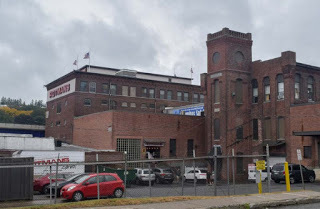 Rottman's Furniture & Carpet storeI am indebted to Ms. Barney for sharing with me her Powerpoint Presentation, (I only wish I had space to cover more of her beautifully researched talk), and to Preservation Worcester for its public education program of talks and walking tours about Worcester’s built environment and its people.
Rottman's Furniture & Carpet storeI am indebted to Ms. Barney for sharing with me her Powerpoint Presentation, (I only wish I had space to cover more of her beautifully researched talk), and to Preservation Worcester for its public education program of talks and walking tours about Worcester’s built environment and its people. *More blogs on Worcester’s lost and surviving places here , here , here , here , and here .
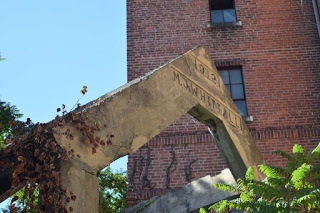
**bio of Whittall and photos of his suburban mansion here .
Photos copyright © 2017 Walter M. Henritze III
Please click on images to enlarge
Published on October 11, 2017 21:30
The Whittal Mills: Survivors of the Industrial Age
 No. 1 Brussels Street
No. 1 Brussels StreetLoretta reports:
Like most cities, my hometown has lost large chunks of its architectural heritage, for a variety of reasons.* Recently, I was surprised and heartened to discover that one large mill complex has managed to survive—not every single building, but most of them—thanks to local business people as well as our dedicated preservationists. Not long ago, under the auspices of Preservation Worcester , Breanna Barney gave a group of nerdy Worcester history people a talk and tour of the Whittall Mills in South Worcester.
 Tower of No. 1 Brussels StreetUntil I attended Ms. Barney’s talk, I didn’t realize that this area was a British enclave. Matthew J. Whittall, ** an Englishman from Kidderminster, had been working in the carpet industry since he was fourteen. At the invitation of George Crompton, who was building a factory to make Brussels carpets, Whittall came to the U.S. in the early 1870s. In 1879, during the global depression, when he found himself unemployed, he decided to go into business for himself. He returned to England, bought eight Crossley carpet looms, and brought them back to Worcester, along with a cousin and a group of Kidderminster carpet weavers.
Tower of No. 1 Brussels StreetUntil I attended Ms. Barney’s talk, I didn’t realize that this area was a British enclave. Matthew J. Whittall, ** an Englishman from Kidderminster, had been working in the carpet industry since he was fourteen. At the invitation of George Crompton, who was building a factory to make Brussels carpets, Whittall came to the U.S. in the early 1870s. In 1879, during the global depression, when he found himself unemployed, he decided to go into business for himself. He returned to England, bought eight Crossley carpet looms, and brought them back to Worcester, along with a cousin and a group of Kidderminster carpet weavers.He was not without strong competition, but by 1901 he’d won, becoming south Worcester’s largest employer. His well-regarded carpets were in Pullman train cars, the Manhattan Opera House, the new Worcester City Hall, and President McKinley’s White house. A sample advertisement is here .
Ms. Barney described him as a paternalistic employer—and this article (which I found after the talk), describing the development of this area, tells a similar story. According to Ms. Barney, in 1910, for instance, business was so good that “Whittall gave weavers an advance in wages.” Furthermore, they would work only 58 hours a week but get paid for 60 hours. This wasn't common behavior among U.S. industrialists, so far as I can ascertain.
 No. 6 Brussels Street (front)
No. 6 Brussels Street (front)
 No. 6 Brussels Street (side view) In the course of my own internet search, I learned that, along with his many contributions to South Worcester, Mr. Whittall made a large donation toward a new chapel in his home town of Kidderminster. I believe it’s safe to call him a philanthropist—all the more reason to be glad his buildings, with his name on them, survive.
No. 6 Brussels Street (side view) In the course of my own internet search, I learned that, along with his many contributions to South Worcester, Mr. Whittall made a large donation toward a new chapel in his home town of Kidderminster. I believe it’s safe to call him a philanthropist—all the more reason to be glad his buildings, with his name on them, survive.Rottman’s Furniture & Carpet Store , across the way, contains under one roof several of the complex’s other buildings. In one place, a round tower juts up. It’s part of a Whittall competitor’s 1884 spinning mill (eventually absorbed by Whittall), and the original spiral staircase is still there, inside the furniture store, as Ms. Barney and her colleagues discovered for themselves.
Rottmans aren’t the only ones in the complex who appreciate these old brick structures and have used their imagination to give them new life. The buildings on Brussels Street house a coffee shop, a realty company, and several other businesses .
 Rottman's Furniture & Carpet storeI am indebted to Ms. Barney for sharing with me her Powerpoint Presentation, (I only wish I had space to cover more of her beautifully researched talk), and to Preservation Worcester for its public education program of talks and walking tours about Worcester’s built environment and its people.
Rottman's Furniture & Carpet storeI am indebted to Ms. Barney for sharing with me her Powerpoint Presentation, (I only wish I had space to cover more of her beautifully researched talk), and to Preservation Worcester for its public education program of talks and walking tours about Worcester’s built environment and its people. *More blogs on Worcester’s lost and surviving places here , here , here , here , and here .

**bio of Whittall and photos of his suburban mansion here .
Photos copyright © 2017 Walter M. Henritze III
Please click on images to enlarge
Published on October 11, 2017 21:30
October 9, 2017
Rings for Mourning General Alexander Hamilton, c1804
 Susan reporting,
Susan reporting,As I've written here before, the sudden death in 1804 of Gen. Alexander Hamilton from wounds suffered during his infamous duel with Col. Aaron Burr shocked a country, and left his family and friends reeling. Overwhelmed with grief, his new widow Elizabeth was too distraught to attend the funeral. She struggled to face life without the man she'd loved and supported, and told others that she longed to die as well. Not only was she left with seven surviving children - the youngest still a toddler - but she also inherited her husband's considerable debts.
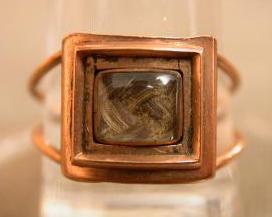
And yet, despite all this, the rituals of death and mourning were observed by the grieving family. Mourning clothing was ordered and worn; Eliza continued to wear a version of the same high-waisted black mourning dress for the rest of her long life. Calls and letters of condolence were received and answered. Before the general was buried, Eliza would have cut and saved locks of his hair.
Hair was among the most precious and treasured of mementos in the 19thc, a lasting link to the deceased. As I shared here , strands of Hamilton's hair were still being given to admirers by his son decades after the general's death. For the family and closest friends, the hair became the centerpiece of mourning rings.
These are two surviving examples of mourning rings ordered by the family to honor Hamilton shortly after his death. The ring, above, was presented by Eliza to one of her husband's friends. Made of gold with a double shank band, the ring includes a braided swatch of Hamilton's hair, preserved under a crystal. Now in the collection of the New-York Historical Society, the ring has survived with its original dome-topped presentation box, covered in red leather and lined with blue and white velvet.
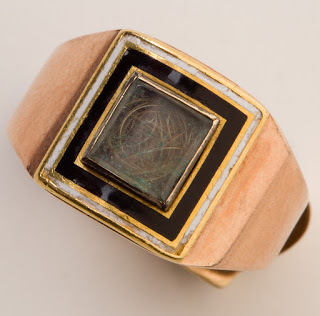
I haven't seen the ring, bottom, in person, but spotted it on an online auction house site. This ring, also gold, features the precious hairs loosely wound together beneath a bevelled crystal, and surrounded by bands of white and black enamel. According to the description, the ring was worn as a pendant, suspended on a ribbon through the gold link added to the ring. The ring was said to have descended directly through the Hamilton-Schuyler family, and is believed to have been worn either by Eliza herself, or one of her daughters.

One thing that I find interesting about both rings are the inscriptions inside. Both are engraved with Hamilton's name, the date of his death, and his age at his death: "46 yrs. 6.mo.", which would make his birth year 1758. Most modern scholars, however, believe that he was born in 1757, or even 1755. Why the discrepancy? The current theory is that Hamilton was self-conscious about entering college at an age older than most of his classmates, and may have shaved a few years from his age before he arrived in New York to begin his studies at King's College. In any event, it's intriguing to think that his wife either didn't know the truth herself, or chose to perpetuate the incorrect date long after it would have mattered.
For more about Eliza Hamilton's life after her husband's death, see this post .
Above: Mourning ring in box, maker unknown, 1805, New-York Historical Society; photo courtesy of N-YHS.
Below: Elizabeth Schuyler Hamilton's Family Mourning Ring, maker unknown, c1804, Clifton & Anderson Art & Antiques; photo courtesy of Clifton & Anderson.
Read more about Eliza Schuyler and Alexander Hamilton in my latest historical novel, I, Eliza Hamilton, now available everywhere.
Published on October 09, 2017 21:00
Mourning Rings for General Hamilton, c1804
 Susan reporting,
Susan reporting,As I've written here before, the sudden death in 1804 of Gen. Alexander Hamilton from wounds suffered during his infamous duel with Col. Aaron Burr shocked a country, and left his family and friends reeling. Overwhelmed with grief, his new widow Elizabeth was too distraught to attend the funeral. She struggled to face life without the man she'd loved and supported, and told others that she longed to die as well. Not only was she left with seven surviving children - the youngest still a toddler - but she also inherited her husband's considerable debts.

And yet, despite all this, the rituals of death and mourning were observed by the grieving family. Mourning clothing was ordered and worn; Eliza continued to wear a version of the same high-waisted black mourning dress for the rest of her long life. Calls and letters of condolence were received and answered. Before the general was buried, Eliza would have cut and saved locks of his hair.
Hair was among the most precious and treasured of mementos in the 19thc, a lasting link to the deceased. As I shared here , strands of Hamilton's hair were still being given to admirers by his son decades after the general's death. For the family and closest friends, the hair became the centerpiece of mourning rings.
These are two surviving examples of mourning rings ordered by the family to honor Hamilton shortly after his death. The ring, above, was presented by Eliza to one of her husband's friends. Made of gold with a double shank band, the ring includes a braided swatch of Hamilton's hair, preserved under a crystal. Now in the collection of the New-York Historical Society, the ring has survived with its original dome-topped presentation box, covered in red leather and lined with blue and white velvet.

I haven't seen the ring, bottom, in person, but spotted it on an online auction house site. This ring, also gold, features the precious hairs loosely wound together beneath a bevelled crystal, and surrounded by bands of white and black enamel. According to the description, the ring was worn as a pendant, suspended on a ribbon through the gold link added to the ring. The ring was said to have descended directly through the Hamilton-Schuyler family, and is believed to have been worn either by Eliza herself, or one of her daughters.

One thing that I find interesting about both rings are the inscriptions inside. Both are engraved with Hamilton's name, the date of his death, and his age at his death: "46 yrs. 6.mo.", which would make his birth year 1758. Most modern scholars, however, believe that he was born in 1757, or even 1755. Why the discrepancy? The current theory is that Hamilton was self-conscious about entering college at an age older than most of his classmates, and may have shaved a few years from his age before he arrived in New York to begin his studies at King's College. In any event, it's intriguing to think that his wife either didn't know the truth herself, or chose to perpetuate the incorrect date long after it would have mattered.
For more about Eliza Hamilton's life after her husband's death, see this post .
Above: Mourning ring in box, maker unknown, 1805, New-York Historical Society; photo courtesy of N-YHS.
Below: Elizabeth Schuyler Hamilton's Family Mourning Ring, maker unknown, c1804, Clifton & Anderson Art & Antiques; photo courtesy of Clifton & Anderson.
Read more about Eliza Schuyler and Alexander Hamilton in my latest historical novel, I, Eliza Hamilton, now available everywhere.
Published on October 09, 2017 21:00



